-

人教版高中英语必修3Canada-the true north说课稿4篇
Good afternoon, teachers, It’s my great pleasure to be here sharing my lesson with you.The content of my lesson is Senior English Book 3 Unit 5 Canada —— “The true North”.I’ll be ready to begin this lesson from five parts. Analysis of the teaching material,the teaching methods,the studying methods, the teaching procedure,and Blackboard design.First, let me talk about the teaching material.Part 1 Teaching Material:This unit is about the introduction of Canada. By studying of this unit,we’ll enable the students to learn the geography, population, main cities, and natural beauty, natural resources of Canada. Through the training of the unit, it also requires students to learn some Language skills such as the expressions of position and emotions.So it plays an important part in the English teaching in this book.After studying the teaching material and analyzing the rule of children’s growing of mind,I think the teaching aims are the followings:1.Knowledge objects:(1) make the students learn some new words and phrases(2) make the students understand the content of the lesson.2.Ability objects:(1)To develop the Ss’ abilities of listening, speaking, reading and writing. Especially reading and speaking ability.(2) learn to talk about the characters of Canada in English(3)To train the Ss’ ability of working in pairs.3.Emotion objects:(1)Enable students to understand the characters of Canada..(2)Stimulate Ss to work hard to make China stronger.Part 2 Teaching Methods:I think helping students learn to master new words and phrases and improve the students’ reading and speaking ability is import and the difficult.According to the analysis of the teaching material and the import points and the difficult points,I will use the following teaching methods : question-guiding approach; fast-reading and careful reading; multi-media teaching methods; discussion

人教版高中英语必修4Women of achievement说课稿4篇
Good morning, distinguished judges:It’s my honor to talk about my teaching ideas with you. Today my topic is Women of Achievement. My presentation consists of six parts: the analysis of teaching material and student, teaching aims, key and difficult points, teaching and studying method, teaching procedures and blackboard design.First, let’s focus on the analysis of teaching material. This lesson is from New Senior English for China Student’s Book 4 Unit 1, the reading part. The main topic of the passage is the introduction of a student of Africanwildlife. After this lesson, the students will learn more information about her studying chimps in Africa, and their reading and speaking abilities can be developed as well.The next part is the analysis of students. My students are in senior high students. They have learnt English for many years, they’ve known many words and sentences, but their speaking and reading abilities are still not very good. So I will practice their speaking and reading abilities through different exercises.According to the New Standard Curriculum and the present situation, I set the teaching aims as follows: firstly, knowledge aims. Students can grasp some new words, such as worthwhile, move off. Moreover, students can understand the content of the passage and get familiar with the topic of studying chimps in wildlife. Secondly, ability aims. Students can use reading strategies such as skimming and scanning in reading process. Thirdly, emotional aims. Students can have the awareness of protecting animals and care about animals.Based on the above analysis, the key point of this lesson is to get the main idea and the detailed information from the passage; the difficult point is to talk about the wildlife protection and use reading strategies.

人教版高中英语必修4Theme parks说课稿3篇
The oldest and the most popular park in the worldenjoy the exciting activities thereget close to the life-size cartoon characters like Mickey Mouse and Donald Duck Step 3 Pre-reading1.What do you suppose a theme park is ?2.What do you think you can see in a theme park?(1.It is a kind of amusement park which has a certain theme – that the whole park is based on. 2.buildings, castles, statues, rare animals and birds, and so on.) Step 4 Reading ----- Theme Parks –---- Fun and More Than Fun1.Predict : Read the title and the pictures on P. 34 and PredictWhat is the meaning of the title “Theme Park – Fun and more than fun”?(The title means that theme parks are fun to visit, but that they can also be educational and can offer useful information.)2.Skimming Fast read and answer:What activities can we take in a theme park?Amusement park: Bumper car Merry-go-round slide bungee jumping Free-fall rides Horror films Pirate ship Ferris wheel roller coaster3.Scanning Read again and you will find various theme parks are mentioned in the passage . Then what are they ?Theme parks: Sports theme park History theme park Culture theme park Marine or Ocean theme Park Future park Science theme park Disneyland4.Careful reading and find the main idea of each paragraph:THEME PARKS---- entertaining/ educationalPara.1 Traditional parks are places to go for relaxation and to have time away from our busy lives.Para.2 Theme parks are different They’re large and full of things to do, see and buy.Para.3 Theme parks are built around a single idea or theme. One example is a sports park.Para.4 Another kind of theme park is historical more and cultural and can be educational.Para.5 Disneylandwas the first theme park. It is based on the fantasy life and characters of Disney’s films.Para.6 Some examples of educational theme parks include sea world parks and science parks.

人教版高中英语必修3Healthy Eating说课稿4篇
Language learning needs a context, which can help the learners to understand the language and then can product comprehensible output, so computer has the advantages to make the materials attractive.Part 3 Learning MethodsTask-based, self-dependent and cooperative learningPart 4 Teaching ProcedureStep One Lead-in“Interest is the best teacher.” Therefore, at the very beginning of the class, I should spark the students’ mind to focus on the centre topic “the band”. I’ll show some pictures of food to attract their attention and then bring some questions.Question:What kind of food they like?What should go into a good meal?The answers must relate to the diet. After this, the students will be eager to know something about a balance diet and this is the very time to naturally lead the class into Step 2Step 2 Reading for information: skimming and scanning In this step, I use Task-based Language Teaching method, which can give students a clear and specific purpose while skimming and scanning the context.Task 1 General ideaThe students will be asked to just glance at the title and the pictures of the passage, and then guess what they will read in the text. And they’ll be divided into groups of four to have a discussion.The purpose is to inspire the students to read actively, not passively. In addition, the task is to develop the students’ reading skill by making prediction and to encourage the students to express their thoughts in English and cooperate with each other.Task 2 Main idea of each paragraphCooperative learning can raise the students’ interest and create an atmosphere of achievement. Based on this theory, I divide the whole class into 4 groups to skim the whole text and get the main idea of each paragraph.

人教版高中英语必修4Working The Land说课稿3篇
Knowledge objectives:(1) to make Ss grasp the usage of words, expressions and sentence structures: statistics, struggle, thanks to, rid of, some patterns for persuasion, the “ing” form as subject and object;(2)to use learnt knowledge to persuade sb.Ability objectives:(1) to develop Ss’ reading skills(skimming, scanning, word guessing);(2) to improve Ss’ speaking, communicating and cooperating skills.Emotional objectives:to make Ss know the contribution of Yuan,and learn his spirit and his simple life time.Teaching important and difficult points:(1) some words, expressions and sentence structures mentioned above;(2)the content of the text;(3)training their reading and speaking skills.Teaching methods: CLT, TBLT,QT.Learning strategies: CLS, QLS, TBLS.Teaching procedures:Step 1 lead-in: (1) teacher plays a piece of recent news from CCTV about the harvest of the super hybrid rice, and ask students whether they know Yuan or not, and talk about him and his contribution.(2)Brain storm: let Ss describe Yuan in their minds including his appearance, his living condition and so on.Step 2 fast reading tasks:(1)teacher introduces Yuan and super hybrid rice(2)make Ss read the text as fast as possible with questions. Such as: what’s the general ideaof this passage? What’s Yuan’ dream? (skimming and scanning skill)Step 3 intensive reading tasks(1)let Ss read the text silently, find topic sentence of each paragraph and draw the difficult sentences and the knowledge what they don’t understand.(words guessing)(2)teacher and Ss talk about the important words, expressions and sentences together, and ask Ss to retell the content of the text.(summarizing and paraphrasing)(3)teacher summarize this part.(4) read again following the courseware.

人教版高中英语必修3The million pound bank note说课稿3篇
在接下来的细读环节,我套用了高考对阅读理解的考查方式设置了5个问题,分别为三个推理判断题,一个细节题和一个主旨大意题。学生需要对文章的内容进行分析、归纳、推理、猜测等高级思维活动才能做出正确的回答。【设计意图】这一过程是对学生进行细读的训练,培养学生获取特定信息和挖掘文章深层次信息的能力。第三环节:Intensive-reading (精读) 15′第三个环节精读,既是最重要的环节,也是突破本课重难点的关键。首先,让学生思考剧本中人物看到百万英镑前后的态度发生了怎样的变化。其次,让学生仔细阅读文章,找出可以表现人物态度变化的具体的语言和动作。最后,让学生总结人物的态度发生变化的根本原因是什么,从而引出Money Talks, 供学生思考。【设计意图】通过一系列的活动培养学生学习从人物的语言和动作探究人物的心理,使学生进一步体会戏剧语言的魅力,从而对文章背后所反映的社会问题进行思考,也为下一步的讨论环节做好铺垫。

人教版高中英语必修5Great scientists说课稿4篇
通过写文章梗概,培养学生综合运用语言的能力,学习用恰当的英语描述科学家的故事。这是本课的教学难点。教师可以使用完形填空的方式来帮助学生整理语篇,从而来降低难度。本课的教学重点的突破方法是:在阅读前,让学生初步了解得出科学观点所需要的基本程序,从而轻松而自然地导入文章的阅读;在阅读过程中,由易到难设计快速阅读和精读的问题,层层推进各种阅读活动,让学生对阅读内容从整体感知到细节理解,最后深层读懂整篇文章,同时加强阅读策略的指导,让每个学生都主动参与课堂教学活动,最终达到提高阅读能力的目的。Step 4 Post-readingGroup Activities四人小组共同合作,在老师的适当指导下,就以下2个问题展开讨论,让学生就所知、所学、所感和所想融入话题,然后抽若干同学代表作小组发言。1. What do you think about John Snow, and what should we learn from him?2. Cholera was 19th century disease, which two diseases are similar to cholera today? Why?

人教版高中英语必修5Life in the Future说课稿5篇
Good afternoon, everyone. It’s my great pleasure to be here sharing my lesson with you. The content of my lesson is Senior English for China Book5 Unit 3 Life in the Future. I’ll be ready to begin this lesson from six parts: Analysis of the teaching material, Analysis of the students, Teaching aims and important and difficult points, Teaching methods and aids, Teaching procedures, and Blackboard design. First, let me talk about the teaching material.Part 1 Analysis of the Teaching Material:This unit is about what human beings’ life will be like in about one thousand years. By studying of this unit, we’ll Enable the students to know the changes in humans’ life and some new inventions bringing about the change and develop the interest in science. This lesson plays an important part in the English teaching in this unit. This is an important lesson in Book Five. From this lesson, it starts asking the Ss to grasp contents of each passage. Therefore, this lesson is in the important position of the teaching material. If the Ss can learn it well, it will be helpful to make the Ss learn the rest of this unit.Part 2 Analysis of the SsAs Senior2 Ss, they are at different levels of English fluency, some of them have lost interest in English. So during the lesson, I arrange a variety of activities to let all of them join in to attract their interest and let them be confident and taste the joy of success.

人教版高中英语必修5The United Kingdom说课稿4篇
Teaching Aims:Knowledge 1. Get the students to learn the useful new words and expressions in this section. Aims:2. Let the students learn about how the UK was formed and the four groups of invaders.1. Develop students’ reading ability and let them learn different Ability reading skills. Aims:2. Enable students to learn to talk about the United Kingdom and the Union Jack Emotional 1. Let students know more about the UK2. Develop students’ sense of cooperative learning Aims:Teaching Important Points:1. Let the students learn about the countries of the United Kingdom and the Union Jack2. Get the students to read the passage and know about how the UK was formed and the four groups of invaders.3. Have the students learn different reading skills.Teaching Difficult Ponts:1. Develop students’ reading ability.2. Enable students to talk about the United Kingdom and the Union Jack.3. Let students learn how the UK was formed geographically and historically.Teaching Methods:Showing pictures, asking, exercising, listening, reading etc.Teaching Aids:A computer,a projector and a blackboard.Teaching Procedures: 1) Show a map of the world, ask students the following questions:Where is the UK?What’s the full name of the UK?2) Ask the students work in pairs to do the quiz on Page 9.Do you want to test how many things you know about the United Kingdom? Let’s have a small test.Using the map on P9, students answer the following questions:?How many countries does the UK consist of? What are they??England is divided into three main areas. Do you know what they are? 1) Scanning (10Minutes )Let the students hold the questions asked in pre-reading and read the passagequickly and then let them do the following exercise.Join lines to the right answer.

北师大版小学数学一年级下册《采松果》说课稿
一、说教材分析《采松果》一课讲的主要内容是:两位数加、减一位数(不进位、不退位),是在学生熟练掌握20以内加、减法以及整十数加、减整十数的基础上安排的。教材内容分为两部分:一部分是教学两位数加一位数,另一部分是教学两位数减一位数。这两部分内容呈现在同一情境图——“采松果”中,创设了一个充满童趣的生活故事场景,引发学生在读懂图意的基础上,发现其中的数学信息,并能利用这些数学信息提出数学问题。二、说学情分析在学习本节课内容之前,学生已认识了100以内的数,掌握了20以内的加减法以及整十数加、减整十数的计算方法,对于加减法的意义有了一个基本的了解。另外经过上半学期的目标性训练,学生已具有了初步的合作交流意识和提出问题、解决问题的能力,能够有目的地进行探索性学习。但是,对于单纯的口算学习学生的学习兴趣并不是很浓,因此,激发学生的学习兴趣,使学生想学、乐学便显得尤为重要。
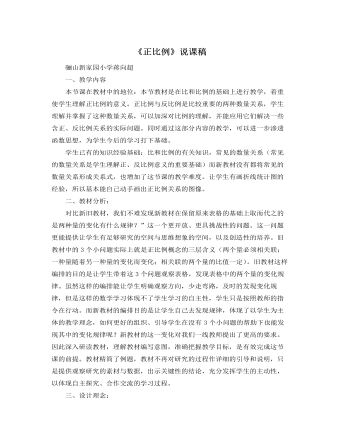
北师大版小学数学六年级下册《正比例》说课稿
{二}、努力实现扶与放的和谐统一,共同构建有效课堂。学生能自己解决的决不包办代替:学生可能完成的,充分相信学生,发挥自主探索与合作交流的优点,让学生有一个充分体验成功展示自我的舞台;学生有困难的,给予适当引导,拒绝无效探究,提高课堂效率。四、教学目标:基于对教材的理解和分析,我将该节课的教学目标定位为:1、帮助学生理解正比例的意义。用字母表示变量之间的关系,加深对正比例的认识。2、通过观察、比较、判断、归纳等方法,培养学生用事物相互联系和发展变化的观点来分析问题,使学生能够根据正比例的意义判断两种量是不是成正比例。3、学生在自主探索,合作交流中获得积极的数学情感体验,得到必要的数学思维训练。
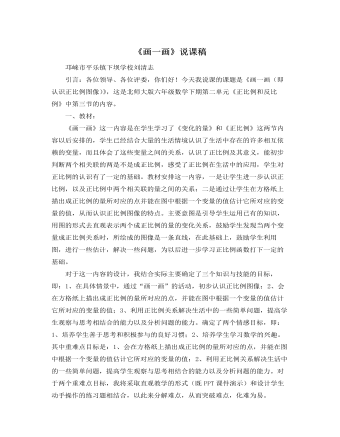
北师大版小学数学六年级下册《画一画》说课稿
一、教材:《画一画》这一内容是在学生学习了《变化的量》和《正比例》这两节内容以后安排的,学生已经结合大量的生活情境认识了生活中存在的许多相互依赖的变量,而且体会了这些变量之间的关系,认识了正比例及其意义,能初步判断两个相关联的两是不是成正比例,感受了正比例在生活中的应用,学生对正比例的认识有了一定的基础。教材安排这一内容,一是让学生进一步认识正比例,以及正比例中两个相关联的量之间的关系;二是通过让学生在方格纸上描出成正比例的量所对应的点并能在图中根据一个变量的值估计它所对应的变量的值,从而认识正比例图像的特点。主要意图是引导学生运用已有的知识,用图的形式去直观表示两个成正比例的量的变化关系,鼓励学生发现当两个变量成正比例关系时,所绘成的图像是一条直线,在此基础上,鼓励学生利用图,进行一些估计,解决一些问题,为以后进一步学习正比例函数打下一定的基础。
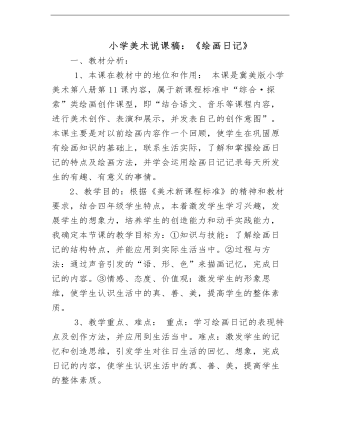
小学美术冀美版四年级下册《11绘画日记》说课稿
2、教学目的:根据《美术新课程标准》的精神和教材要求,结合四年级学生特点,本着激发学生学习兴趣,发展学生的想象力,培养学生的创造能力和动手实践能力,我确定本节课的教学目标为:①知识与技能:了解绘画日记的结构特点,并能应用到实际生活当中。②过程与方法:通过声音引发的“语、形、色”来描画记忆,完成日记的内容。③情感、态度、价值观:激发学生的形象思维,使学生认识生活中的真、善、美,提高学生的整体素质。
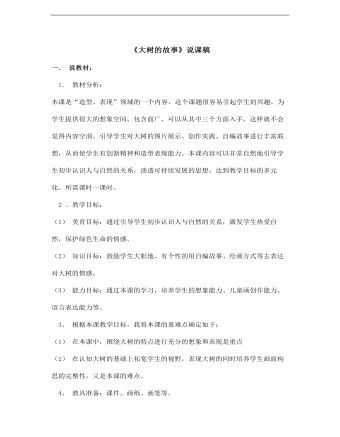
小学美术冀美版一年级下册《19大树的故事》说课稿
(1) 美育目标:通过引导学生初步认识人与自然的关系,激发学生热爱自然,保护绿色生命的情感。(2) 知识目标:鼓励学生大胆地、有个性的用自编故事、绘画方式等去表达对大树的情感。(3) 能力目标:通过本课的学习,培养学生的想象能力、儿童画创作能力、语言表达能力等。
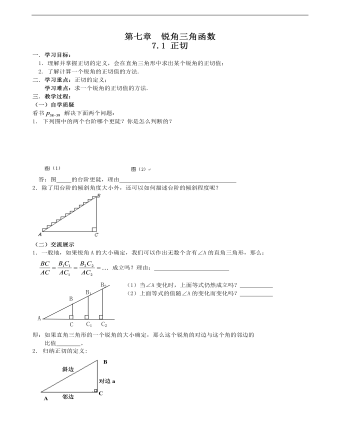
初中数学苏科版九年级下册《71正切》说课稿
(一)自学质疑看书 解决下面两个问题:1.下列图中的两个台阶哪个更陡?你是怎么判断的? 答:图 的台阶更陡,理由 2.除了用台阶的倾斜角度大小外,还可以如何描述台阶的倾斜程度呢?
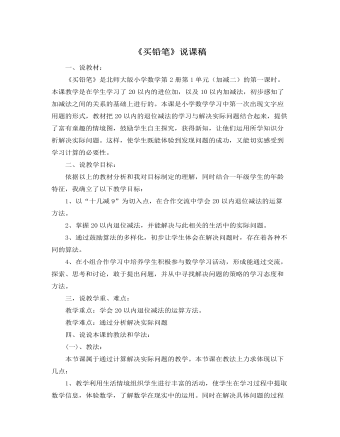
北师大版小学数学一年级下册《买铅笔》说课稿
2、求还剩多少枝要用什么方法来计算?(请几名学生说一说,再同桌互相说一说,在说的过程中掌握解决问题的方法)3、为什么用减法?你是怎么想的?(请几名学生说一说)师:你能根据要求列出算式来吗?(请学生在纸上列算式)(学生经过10以内的加减法的学习以及20以内进位加法的学习和长时间的培养,已经具备了根据数学问题列出式子的能力。因此学生根据问题,能很快的列出式子。)请学生回答。老师板书:15-9=(分析:1,“15,9”分别表示什么?)4、你是怎么来计算的(先让学生进行自主的探究,寻找计算方法。探究性学习必须要有独立思考的时间。由于学生的学习能力存在差异,对15-9的理解也存在不同,只有让学生经过独立思考,才能让他们真正的掌握知识。)
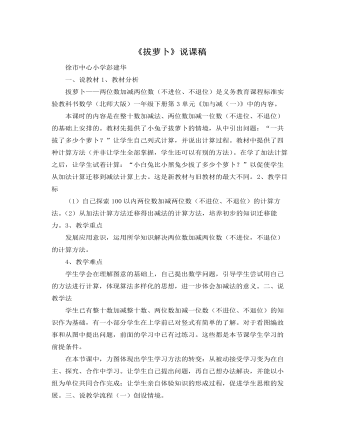
北师大版小学数学一年级下册《拔萝卜》说课稿
发展应用意识,运用所学知识解决两位数加减两位数(不进位,不退位)的计算方法。4、教学难点学生学会在理解图意的基础上,自己提出数学问题,引导学生尝试用自己的方法进行计算,体现算法多样化的思想,进一步体会加减法的意义。二、说教学法学生已有整十数加减整十数、两位数加减一位数(不进位、不退位)的知识作为基础,有一小部分学生在上学前已对竖式有简单的了解。对于看图编故事和从图中提出问题,前面的学习中已有过练习。这些都是本节课学生学习的前提条件。在本节课中,力图体现出学生学习方法的转变:从被动接受学习变为在自主、探究、合作中学习。让学生自己提出问题,再自己想办法解决,并能以小组为单位共同合作完成;让学生亲自体验知识的形成过程,促进学生思维的发展。三、说教学流程(一)创设情境。
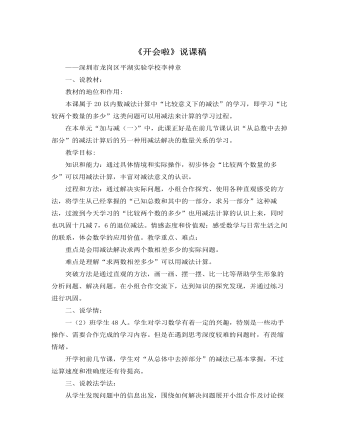
北师大版小学数学一年级下册《开会啦》说课稿
三、说教法学法:从学生发现问题中的信息出发,围绕如何解决问题展开小组合作及讨论探究,运用已学过的知识,共同寻找解决问题的方法。再在解决问题的基础上,进一步通过练习和解决实际问题,对所学知识进行巩固应用。结合本班学生的学习特点,教法我采用情景引导、问题引导和活动评价。学法主要让学生通过观察思考,自主探究、合作交流,同时也应用已有的知识进行引导转化学习。同时也尝试四人小组的形式来探究问题和解决问题。四、说教学过程:首先我安排的是一(2)班的班干部们要开会了,出示完情景图后,让学生观察并说说图中的数学信息。如有11位同学要开会,现在只有7把椅子。(板书课题:开会啦)接着出示问题:“每人坐一把椅子,够吗?”让学生通过小组讨论后,请代表说一说自己的想法。学生发现有11个人,才7把椅子,不够坐。同时还可能出现一些学过的知识内容,如数量大小的比较:11>7让学生通过小组讨论后,请代表说一说自己的想法。
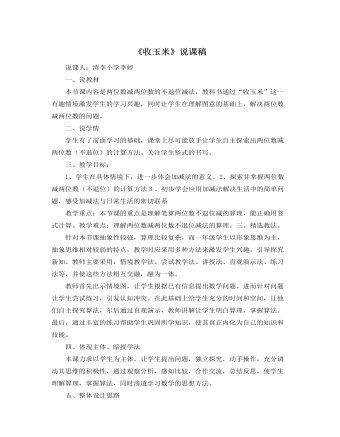
北师大版小学数学一年级下册《收玉米》说课稿
二、说学情学生有了前面学习的基础,课堂上尽可能放手让学生自主探索出两位数减两位数(不退位)的计算方法。关注学生竖式的书写。三、教学目标:1、学生在具体情境下,进一步体会加减法的意义。2、探索并掌握两位数减两位数(不退位)的计算方法3、初步学会应用加减法解决生活中的简单问题,感受加减法与日常生活的密切联系教学重点:本节课的重点是理解笔算两位数不退位减的算理,能正确用竖式计算。教学难点:理解两位数减两位数不退位减法的算理。三、精选教法。针对本节课抽象性较强,算理比较复杂,而一年级学生以形象思维为主,抽象思维相对较弱的特点,教学时应采用多种方法来激发学生兴趣,引导探究新知。教师主要采用:情境教学法、尝试教学法、讲授法、直观演示法、练习法等,并使这些方法相互交融,融为一体。
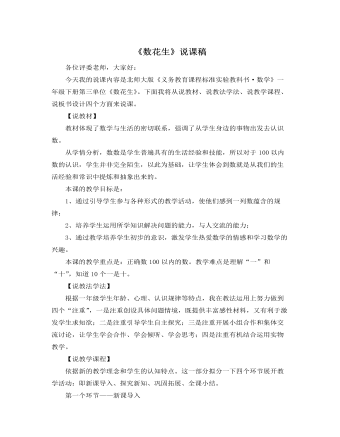
北师大版小学数学一年级下册《数花生》说课稿
各位评委老师,大家好:今天我的说课内容是北师大版《义务教育课程标准实验教科书·数学》一年级下册第三单位《数花生》。下面我将从说教材、说教法学法、说教学课程、说板书设计四个方面来说课。【说教材】教材体现了数学与生活的密切联系,强调了从学生身边的事物出发去认识数。从学情分析,数数是学生普遍具有的生活经验和技能,所以对于100以内数的认识,学生并非完全陌生,以此为基础,让学生体会到数就是从我们的生活经验和常识中提炼和抽象出来的。本课的教学目标是:1、通过引导学生参与各种形式的教学活动,使他们感到一列数蕴含的规律;2、培养学生运用所学知识解决问题的能力,与人交流的能力;3、通过教学培养学生初步的意识,激发学生热爱数学的情感和学习数学的兴趣。

